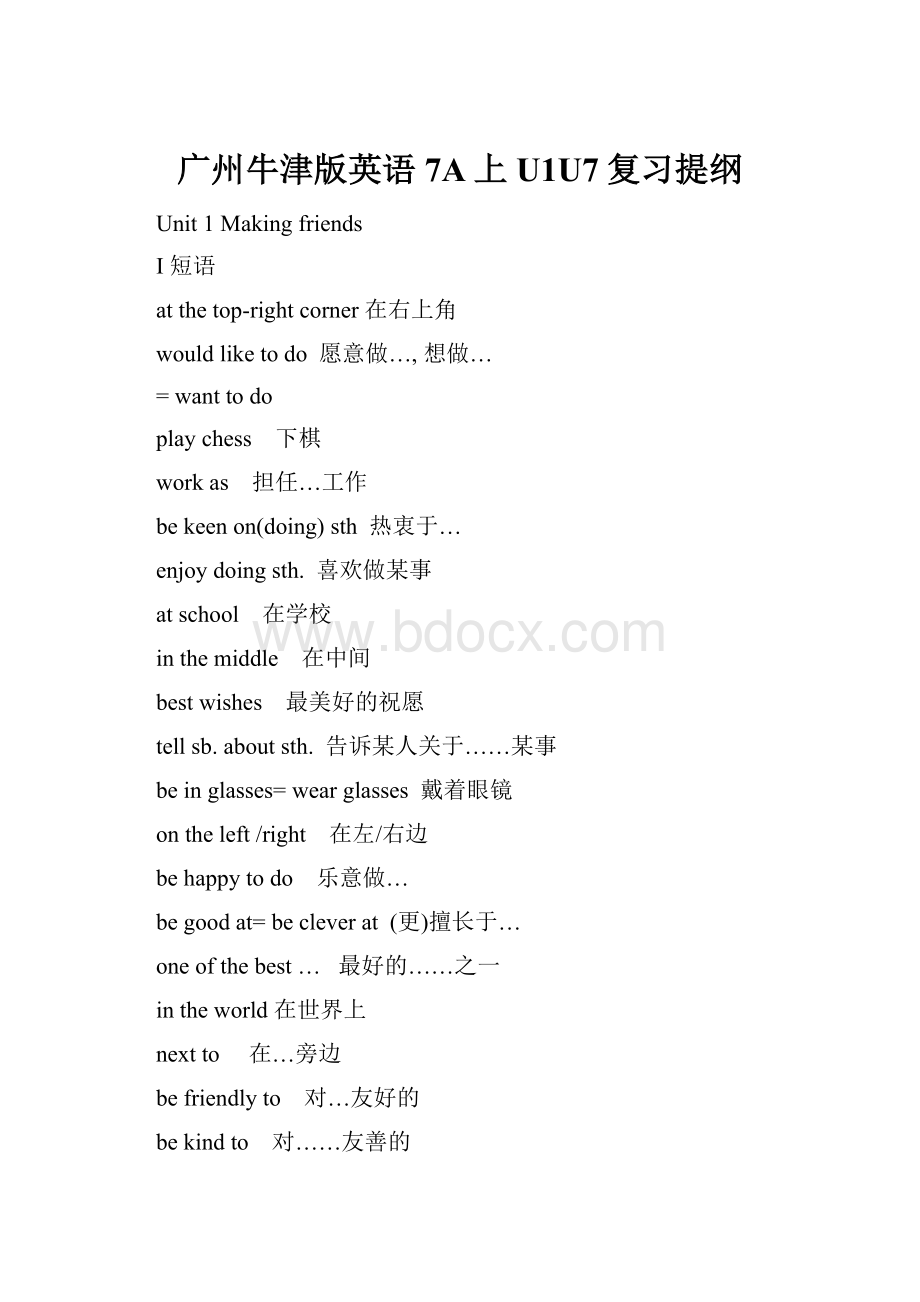广州牛津版英语7A上U1U7复习提纲.docx
《广州牛津版英语7A上U1U7复习提纲.docx》由会员分享,可在线阅读,更多相关《广州牛津版英语7A上U1U7复习提纲.docx(31页珍藏版)》请在冰豆网上搜索。

广州牛津版英语7A上U1U7复习提纲
Unit1Makingfriends
I短语
atthetop-rightcorner在右上角
wouldliketodo愿意做…,想做…
=wanttodo
playchess下棋
workas担任…工作
bekeenon(doing)sth热衷于…
enjoydoingsth.喜欢做某事
atschool在学校
inthemiddle在中间
bestwishes最美好的祝愿
tellsb.aboutsth.告诉某人关于……某事
beinglasses=wearglasses戴着眼镜
ontheleft/right在左/右边
behappytodo乐意做…
begoodat=becleverat(更)擅长于…
oneofthebest…最好的……之一
intheworld在世界上
nextto在…旁边
befriendlyto对…友好的
bekindto对……友善的
atmidnight在午夜
givesb.alotofhelp
=giavalotofhelptosb给予某人帮助
doexercise锻炼身体
lastfor持续(一段时间)
from…to…从…到
lotsof=alotof许多
atthebeginning/endof在…的开头/结尾
inautumn/winter…在秋天/冬天
goskiing去滑雪
gotothesea去海边
Noproblem没问题
II句型及语法
1.谈论喜好:
enjoy(doing)sth.bekeenon(doing)sth.My(favourite)hobbyis…(doing)…
liketodo/doingsth.wouldliketodo(’dliketodo)=wanttodo
Iwouldliketobeyourpen-friend.我想成为你的笔友。
Iaminterestedindrawing.我对画画感兴趣。
Iamkeenondrawing.我热衷于画画。
Ienjoydrawing.我喜欢画画。
Myfavouritehobbyisdrawing.我喜欢画画。
2.特殊疑问句要点:
1)改句时,原句中如有助动词(be,can,must,shall,will等)的,把第一个助动词提前;没助动词的,加do(各时态)
2)对主语提问时,用what或who代替划线部分,动词不变,如:
Jimworkshardestinourclass.→Whoworkshardestinyourclass?
3)对形容词、副词、及表方式的介词短语提问,用how
Peopleworkoutdifficultproblemswithcomputers.→Howdopeopleworkoutdifficultproblems?
4)对频率(如onceaweek,twiceamonth,)提问,用howoften
Ivisitmygrandparentstwiceamonth.→Howoftendoyouvisityourgrandparents?
3.冠词:
1)注意以下冠词:
auniversityaEuropeanboyausefulbookauniform
anunluckycatanhouranhonestgirl
2)球类运动不加冠词,乐器要加the,如:
playfootball,playthepiano
3)注意以下几组短语中的冠词:
bybus&takeabushavedinner&haveaquickdinnerwatchTV&listentotheradio
4.提建议
1)Whynotdo…?
=Whydon’tyoudo…?
为什么不……呢?
2)What/Howabout(doing)sth.?
…怎么样?
WhynotgotoParis?
=Whydon’tyougotoParis?
What/HowaboutgoingtoParis?
为什么不去巴黎呢?
5.书信的格式要点:
1)地址:
放在右上角,从小地点到大地点:
如,No1.MiddleSchool,Guangzhou,China
2)日期放在地址下方。
3)Dear…后不用标点
4)结尾部分:
要加上yours,love等,再换行写名。
5)注意:
考试中不能出现真实的个人信息。
III交际用语
1.介绍个人信息,家庭,学校
2.书信写作
Unit2Ourdailylife
(一)短语
topstudent优等生
havebreakfast/lunch/dinner吃早/午/晚餐
haveanearlydinner早早地吃晚餐
bedifferentfrom不同于……
bethesameas…和……一样
findout查明;找出(真相)
atschool/work在校/工作
atbreakfast在吃早餐时
puton穿上
schooluniform校服
inmyowncar用我自己的车
*bycar(原形)乘车
makephonecallstosb打电话给某人
ontheway(to)…在…的路上
failanexam测验不及格
once/twiceaweek一周一次/两次
picksbupfromschool从学校接某人
comebackto…=returnto回到……
havepianolessons上钢琴课
inanhourortwo用一两小时
=inoneortwohours
continuedoingsth继续做…
workon…忙于……,努力于……
juniorhighschool初级中学
walkhome步行回家
getto+place=
arriveat/in+place到达
spend…onsth花费
=spend…(in)doingsth
playthepiano弹钢琴
atadesk在桌旁
beinchargeof管理
lookafter
=takecareof照顾
makesth.+adj.使…怎样
theonlychild独生子女
belateforschool上学迟到
tellthetruth说出真相
getangry生气
gojogging慢跑
liveahealthylife过着健康的生活
onweekdays从周一到周五
exceptfor除了
(二)句型及语法
1.oneof+名词复数:
表示…之一
ChengNaisoneofthetopstudentsinGuangzhou.(top=thebest)
ChengNa是广州市最好的学生之一。
2.puton&wear
puton穿上,表动作,瞬间动作Putonyourcoat.
wear穿着,表状态,持续动作Youarewearingacoat.
3.at…相当于when….表状态:
at(/)schoolat(/)work中间没有冠词
Everymorningwediscussbusinesswhenwearehavingbreakfast.
=Everymorningwediscussbusinessatbreakfast.
4.注意对比以下短语:
onthewaytoschoolontheway(/)home
returntoschoolreturn(/)homehome作adv.,前面不用介词
inherowncar/onmybikebycar(有adj.用in或on,无adj.直接用by)
havedinnerhaveanearlydinner(三餐前有限定词时,要加冠词)
5.到达:
getto&reach&arrivegetto=reach=arrivein/at:
后面均接地点
arrive(vi.)arrive后可以不接介词短语,单独使用;接地点时,at+小地方,in+大地方
get,reach,arrive后接there,here,home等副词时,不需加介词。
Whenwillthetrainarrive?
(单独使用)火车什么时候到?
Igetto/arriveat/reachthestationatsix.我六点到车站。
Igot/arrived/reachedheretenminutesago.我十分钟前到这里。
6.以下动词后面只接动词的ing形式,不能接todo:
finish(完成),enjoy(喜欢),practise(练习),mind(介意),keep(一直做…)
Ienjoypractisingplayingthepiano.我喜欢练习弹钢琴。
Ifinishedcleaningthehouse.我清洁完屋子了。
7.表花费:
sb.spend(s)/spent…onsth.sb.spend(s)/spent…(in)doingsth.
ittakes/tooksb.…todosth.
注意各句型中的主语、介词及动词(本身及后面接的动词)的形式
Ispendtenyuan(in)buyingthisbook.=Ispendtenyuanonthisbook.
8.一般现在时要点:
1)一般现在时表示:
经常发生的、目前状态、客观现实
ChengNaisatopstudent.(目前状态)
Shewritescomputergames.(经常发生)
Theearthtravelsaroundthesun(客观现实)
2)一般现在时构成:
第三人称单数谓语动词加-s,其它人称谓语动词用原形。
SheoftencleansherhouseonSundays.
IoftencleanmyhouseonSundays.
3)改否定句或疑问句:
含be动词:
在be后面加not;把be动词提前。
Iamnotyoung.否定:
Iamnotyoung.疑问句:
Areyouyoung?
不含be动词(以want为例):
在动词前加don’t/doesn’t,或在句首加Do/Does,并把动词改为原形;
Hewantstogo.否定:
Hedoesn’twanttogo.疑问句:
Doeshewanttogo?
9.频率副词(always,usually,often,sometimes,seldom,never,onceaweek等)要点:
1)用法:
通常用在一般现在时,但可根据上下文用于过去时。
2)对频度副词提问,用Howoften
Hevisitshisgrandparentstwiceamonth.→Howoftendoeshevisithisgrandparents?
3)位置:
助动词(be,do)后、行为动词前
Sheoftengetsupat6:
30.
Sheisneverlateforschool.
Shedoesn’tusuallygotoschoolonfoot.
10.描述人物外貌
in+衣着inbluedress穿着蓝色连衣裙
with+名词+(介词短语)withababyinherhand手中抱着一个婴儿
(三)交际用语
描述日常生活工作
Unit3Troubles
I短语
happento发生
waitfor等待
begindoing=begintodo开始做某事
arguewithsb.与某人吵架
holdout拿出
showsb.sth.=showsth.tosb给…看
stareat盯着
steal(stole)sth.fromsb.从某人偷到…
findsth.missing发现…丢失
runaway逃跑
hurryaboard匆忙上船
goafter=follow跟随
pickup拿起,载走
afew一些
geton/off上/下车
seesb.do(ing)sth.看见某人做某事
inhandcuffs带手铐
welldone干得好
helpsb.(to)dosth.帮助某人做某事
=helpsb.withsth.
intime及时
stayuplate(forsth.)(为…)熬夜
besuretodo确定
beangrywith对…生气
pullon匆忙穿上衣服
stormoutof冲出来
keepwarm保暖
thinkabout考虑
decidetodo决定做某事
fallover摔倒
walk/lookround四处走/看
onone’sown靠某人自己
feelguilty感到内疚
haveanidea想到一个办法
onthesideof在…一边
inahurry匆忙地
haveto不得不
beworriedabout担心
tellsb.(not)todo告诉某人做某事
muchbetter更好
takeplace发生
askfor向…要
ontime准时
intime及时
havetimeforfun有时间玩
fewerandfewer越来越少
gotouniversity上大学
inthefuture在未来
haveachoice有选择
withoutquestion没有问题
compare…to/with与…比较
as+adj/adv.as…与…一样…
changeone’smind改变主意
allowsb.(not)todo允许某人做某事
toomuchtrouble太多麻烦
discusswithsb.与某人讨论…
either…or…或者...或者…
ought(not)todo应该
atuniversity在大学
rightaway立刻
tellalie说谎
havereasonsfor有理由做…
beimportantfor对…重要
invitesb.todo邀请某人做某事
try(not)todo努力做某事
careabout关心
whynotdo为什么不(表建议)
=whydon’tyoudo
strongpoints特长
goacross=cross渡过
justatthatmoment就在那时
comeupto走过来
stayinhospital住院
hopetodo希望做某事
assoonaspossible尽快
=assoonasonecan
lookup查找(字典等资料)
II句型及语法
1.常见双宾语结构的动词:
show,bring,give
showsb.sth.=showsth.tosb.向某人展示…
Ishowyouanewbook.=Ishowanewbooktoyou.
2.穿过:
cross&across
crossv.
acrossprep.在句中通常与动词连用
Icrosstheroadquickly.我很快地过马路。
Igoacrosstheroadquickly.
3.名词做定语:
1)名词直接作定语时,通常用单数形式:
apaperbag,somegirlpupils,twoboystudents
2)man,woman作定语时可以用单数和复数两种形式,但须随所修饰名词的数而定:
amandoctor-twomendoctorsawomantourist-threewomentourists
4.Itis+adj.+todosth.做某事是…的
Tofinishtheworkinanhourisdifficult.
=Itisdifficulttofinishtheworkinanhour.
一个小时完成这项工作是很难的。
5.maybe&maybe
maybe是情态动词may+be,通常用在句中
maybe=perhaps,通常用在句首
Maybeheisathome.=Hemaybeathome.
6.hurrytodo,inahurry=hurriedly匆忙
Ihurriedtoschool.=Iwenttoschoolinahurry.=Iwenttoschoolhurriedly.
7.onone’sown=byoneself靠某人自己
Healwaysgoesoutonhisown.他总是自己出去。
=Healwaysgoesoutbyhimself.
8.as…aspossible=as…as+主语+can/could尽可能
I’llcomeassoonaspossible.我会尽可能快回来。
=I’llcomeassoonasIcan.
9.本单元部分动词用法归纳:
1)see/find/hearsb.doingsth.强调某事正在发生
Isawhimplaygamesintheplaygroundjustnow.我刚刚看见他在操场玩游戏。
2)以下动词后面要接形容词:
be,keep,feel,look,smell,taste,sound,turn,get,become
keepwarm保暖feelguilty感到内疚
3)以下动词后面只接sb.(not)todosth.:
tell,ask,allow,invite
Itoldhimnottobelate.我告诉他不要迟到。
4)以下动词后面只接(not)todosth.:
decide,try,hope
Idecidedtoleavehere.我决定离开这里。
5)以下动词后面只接sb.(not)dosth.:
make,let
Ican’tlethimstayalone.我不能把他单独留下。
6)以下动词后面只接动词原形:
should,oughtto,haveto,must
YououghtnottotellJimaboutit.你不应该把它告诉Jim.
7)helpsb.(to)dosth.=helpsb.withsth.帮助某人做某事
Ialwayshelpmymother(to)dosomehousework.=Ialwayshelpmymotherwiththehousework.
10.一般过去时要点:
1)一般过去时表示:
过去发生的(一次或经常性的)动作或存在的状态
Shehurtherlegyesterday.(一次性)
Hewasoftenlateforworklastyear.(经常性,可与频度副词连用)
2)表示过去的时间状语:
yesterday,last(week),in(1949),(twodays)ago,justnow…
3)一般过去时构成:
动词的过去式(注意识记本册出现的不规则动词)
III交际用语
1.描述人物外貌
2.描述过去发生的事情
Unit4Hobbies
一、重点词组:
usedtodo,billionsof,seesbdo/doingsth,fromone…toanother,notAbutB,aswellas,allovertheworld,takephotographs,forexample,inthepast,makefriends,getexcited,atthebeginning/endof,growup,
inasecond,takepartin,thinkof,inasecond
二、重点句型:
whenIwasyoung,Ididnotusetohavemuchmoney.
Iusedtogoout